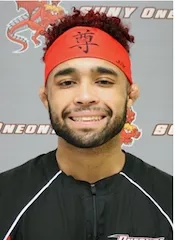SUNY Oneonta’s Africana & Latinx Studies [initially Black and Hispanic Studies] Department owes its existence, as do other Black Studies, Latinx Studies, and Ethnic Studies programs on other American campuses, to the activism and struggles of students and faculty in the late1960s. Within SUNY, activists’ pressure led to the SUNY Council of Presidents in Fall 1968 to recommend: that every campus add Black Studies to its curriculum, begin majors where appropriate, schedule black artists and cultural activities on campus, and incorporate students into the planning process (1).
In April 1969 a group of students occupied the SUNY Oneonta President’s office and prepared to stay indefinitely until their eleven demands were met, which included admitting two hundred more black students, a black director of EOP, black counselors in Admissions and EOP, a black cultural center, and many more black professors. By the end of the 1969-70 year, SUNY Oneonta faculty approved the creation of a Black Studies Program with additional efforts to include Hispanic Studies in the curriculum, and Charles L. James of the English Department became the first director. In1965, there were only twelve black students and no black faculty whereas by 1970 there were approximately two hundred students and a few faculty and staff of color, especially after the creation of the Educational Opportunity Program (EOP) at the decade’s end (2). To further ensure fulfillment of the goals of the students, a B.H.Task Force was created to oversee the fulfillment of the goals for the first decade.
Born in a time of struggle for multiracial inclusion and education of relevance to all students, the Black and Hispanic Studies department had to fight for acceptance within the SUNY Oneonta community, struggle to build working relationships with other departments unhappy to share faculty and courses in order to develop a relevant and rigorous curriculum, and create a space of refuge for students of color who experienced ongoing racism on campus and in the city of Oneonta. These issues have frequently re-surfaced. In 1970 a black cultural center, Karibu, was opened in Morris Hall basement and became the soul of black student life, but closed in 1982 when Morris Hall was renovated (3). This issue of a space on a HWCU (historically white college-university) for students of color continued and resurfaced as a demand after the infamous Oneonta Blacklist of September 1992 (4) which led to the opening of the Center for Multicultural Experiences within Lee Hall in February 1993. From the department’s inception, institutional support for Hispanic/Latinx Studies was limited and inconsistent—no dedicated full-time faculty were assigned until 2013, despite repeated external program reviews reporting the need for active administrative support for faculty lines. The department is hopeful of faculty growth, though cognizant that US demographic changes drive this, and we still lack the human resources to meet the growing Latinx student population.
Strong leadership at the onset enabled BHS to thrive. Charles L. James, the first director who was recruited by Swarthmore in 1973, was replaced by Dr. Ena Campbell for two years, and then for several years, the chair was Dr. Guy C.Z. Mhone, a Malawian development economist, later renowned for his contributions to the field and for whom CODESRIA Institute (Dakar, Senegal) holds regular development conferences in his name to honor his work (5). All BHS/ALS chairpersons have sought to emulate the example of commitment and integrity of the department’s founders.
Now in its fifth decade, SUNY Oneonta’s Africana and Latinx Studies Department, similar to other interdisciplines, still struggles for recognition, survival, and growth. Nonetheless, our mission is just as vital as ever. College and university graduates need a broad knowledge of other American cultures within a global context because of the persistence and the increasing importance of race, ethnicity, class, and gender as social realities affecting everyone on the globe. ALS provides the conceptual tools and cultural competencies required to navigate the complex socio-economic, cultural, and political milieu of the twenty-first century.
Endnotes:
1. Cary W. Brush, In Honor and Good Faith: Completing the First Century, 1965-1990 (SUNY Oneonta Alumni Association, 1997) pp 31-33
2. Brush, In Honor and Good Faith, 110-111
3. The State Times, 18 March 1982
4. OSC’s administration created a list of all black student males which they turned over to all local police agencies investigating a break-in and attempted assault. This ‘racial profiling’ legal case of 13 years duration is now taught at US law schools. One result in the 1993-96 period was a major decline in student enrolments.
5. http://kemetforum.com/blog1.php/african-to-remmember-late-prof. Accessed, 3 July 2013;http://www.codesria.org/IMG/pdf/2008_Repenser_la_politique_commerciale_et.pdf. Accessed 3 July 2013

